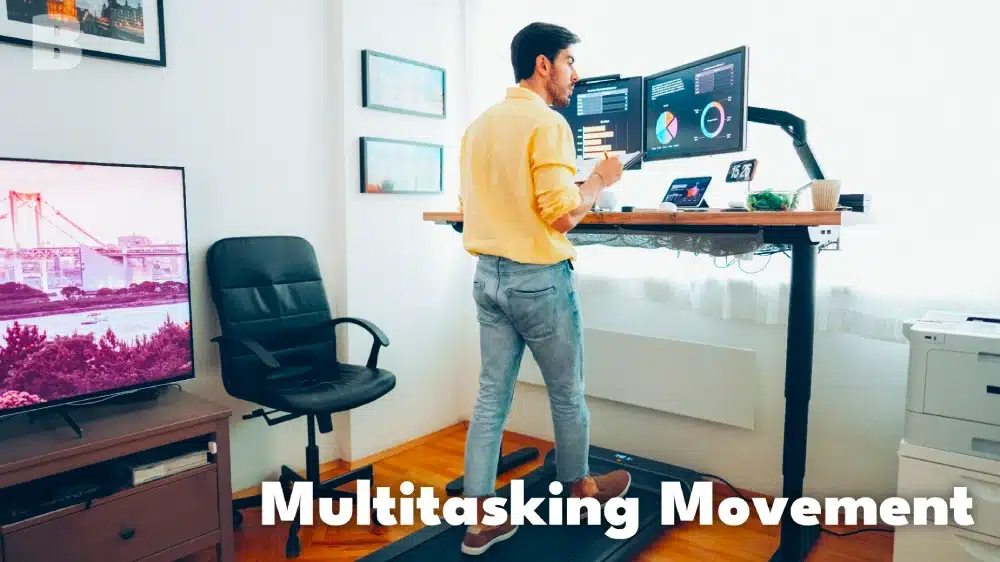Struggling to squeeze exercise into your already packed schedule? You’re not alone!
“Lack of time” consistently tops the list of excuses keeping people from getting active.
But what if we told you there are 17 sneaky strategies to outsmart this time crunch and transform your fitness routine?
This article dives deep into overcoming the “no time” hurdle, revealing creative solutions to get your body moving and improve your health, even with a busy lifestyle.
Jump to:
Reframing Your Mindset
1. The Importance of “Why”
Discovering your deeper motivation transforms the exercise journey from a chore to a personal mission. Whether the aim is enhancing health, reducing stress, or boosting energy, setting specific, meaningful goals acts as a powerful catalyst.
Research underscores the significance of a well-defined “why” in sustaining exercise routines. According to a study, health self-determinism, reflecting intrinsic motivation, predicts adherence to resistance training, emphasizing the importance of intrinsic motivations over extrinsic factors for maintaining regular exercise (Kathrins & Turbow, 2010).
2. “Non-Workout” Workouts

The concept of Non-Exercise Activity Thermogenesis (NEAT) sheds light on the underrated aspect of calorie burning. NEAT encompasses all activities outside formal exercise, such as walking, standing, and even fidgeting.
Research highlights NEAT’s role in daily energy expenditure, suggesting it can significantly impact weight management. By integrating more movement into everyday tasks—opting for stairs over elevators, or standing desks over sitting ones—individuals can enhance their metabolic rate without setting aside dedicated time for workouts (Pontzer et al., 2021)..
Finding Hidden Time
3. Audit Your Day
Initiating a personal time audit can unveil surprising opportunities for exercise. By meticulously logging daily activities, one might discover intervals previously overlooked that are ripe for incorporating physical activity.
Research exploring the link between physical activity accumulated in bouts and all-cause mortality found that the total amount of moderate-to-vigorous physical activity (MVPA), regardless of how it’s accumulated, is associated with reduced mortality risk. This suggests that both continuous and intermittent activity patterns are beneficial for longevity (Saint-Maurice et al., 2018).
This process of self-examination encourages a more mindful approach to time management, paving the way for exercise to be seamlessly integrated into one’s schedule.
4. Multitasking Movement

Integrating movement into routine tasks presents a practical strategy for those claiming time scarcity. Simple adjustments, such as taking walks during phone calls or performing stretches while engrossed in a television series, can cumulatively have a profound impact on physical well-being.
research suggests that high body weight leads to high total daily energy expenditure (TDEE) and activity energy expenditure (AEE), which might obscure the fact that obese individuals are less physically active than lean individuals. It implies that low-intensity activities, contributing to the AEE, are critical components of daily energy balance, especially in the context of obesity management (DeLany et al., 2013).
5. Mini-Workout Moments
The concept of mini-workout moments revolves around the idea that fitness does not necessarily require long, uninterrupted periods. Instead, distributing 5–10 minute bursts of exercise throughout the day can collectively fulfill, if not exceed, daily activity targets.
A 7-minute workout composed of aerobic and resistance exercises, conducted daily for 6 weeks, showed significant improvements in body weight and composition among normal weight individuals. Participants experienced a decrease in waist circumference, suggesting a positive impact on cardio-protective nutritional status without changing eating habits (Mattar, Farran, & Bakhour, 2017).
Embracing Efficiency
6. High-Intensity Workouts
High-Intensity Interval Training (HIIT), circuit training, and supersets stand as pillars of efficiency in the fitness realm. These modalities are celebrated for their ability to deliver maximal health benefits within minimal time frames.
HIIT, for instance, alternates short bursts of intense activity with brief recovery periods, effectively enhancing cardiovascular fitness, fat loss, and muscle endurance. Circuit training sequences different exercises with minimal rest, ensuring a comprehensive workout in a condensed period. Supersets, which involve performing two exercises back-to-back without rest, not only save time but also increase workout intensity.
High-Intensity Interval Training (HIIT) has been shown to offer significant health benefits for individuals, including improved cardiovascular health, increased insulin sensitivity, and significant fat loss, often in less time than traditional endurance workouts (G. Fisher et al., 2015).
7. Workout Apps and Online Resources
The digital age brings fitness to your fingertips, making it easier than ever to access expert-guided workouts anytime, anywhere. Workout apps and online resources offer a plethora of options to fit any schedule, preference, and fitness level.
Platforms like MyFitnessPal and Nike Training Club provide users with customizable workout plans, instructional videos, and progress tracking, all designed to maximize workout efficiency. This convenience eliminates the time and logistical barriers associated with traditional gym workouts, empowering individuals to maintain their fitness regimen consistently.
8. The Power of Planning
Scheduling workouts with the same priority as important appointments is a game-changer for time management. This proactive approach ensures that exercise is integrated into daily routines, rather than being left to chance. By allocating specific times for physical activity, individuals can avoid the common pitfall of indefinite postponement.
Predicting physical exercise adherence through deep learning approaches using data from fitness apps shows that planning and monitoring can significantly influence adherence rates. This indicates that the use of technology in planning and tracking exercise sessions may help in maintaining adherence to fitness goals (Jossa-Bastidas et al., 2021).
Beyond the Gym
9. Outdoor Exploration
Exploring the great outdoors offers a refreshing alternative to traditional gym environments, blending physical activity with the beauty of nature. Activities such as hiking, running, and biking not only provide substantial cardiovascular benefits but also enrich the soul.
Outdoor exercise, compared to indoor, is associated with greater feelings of revitalization, positive engagement, decreases in tension, confusion, anger, and depression, and increased energy. Participants also reported greater enjoyment and satisfaction with outdoor activities, suggesting potential for increased activity adherence (Coon et al., 2011).
10. Home Fitness Solutions

The rise of home fitness solutions has democratized access to exercise, proving that effective workouts don’t necessarily require expensive equipment or gym memberships. Techniques like bodyweight training, utilizing resistance bands, or incorporating minimal equipment such as kettlebells, offer versatile and efficient ways to achieve fitness goals from the comfort of one’s home.
Home-based exercise programs were found to improve muscle strength, muscle power, muscular endurance, and balance in healthy older adults, offering a practical alternative to counteract physical inactivity and preserve/improve health and fitness (Chaabene et al., 2021).
11. Active Socializing
Integrating social elements into fitness routines can significantly enhance motivation and enjoyment. Participating in group fitness classes, joining sports leagues, or organizing active meetups with friends encourages accountability and provides a supportive community.
A study revealed that exercising with others positively influenced mental well-being compared to exercising alone. The findings suggest engaging in exercise with others could be more effective in improving mental well-being (Harada, Masumoto, & Kondo, 2019).
Embracing Technology
12. Gamifying Fitness
Leveraging fitness tracking apps to gamify exercise routines presents a novel approach to bolster motivation. These platforms transform mundane workouts into interesting challenges, complete with rewards and progress tracking.
Apps like Fitbit and Strava utilize elements of competition and achievement to engage users, effectively turning fitness goals into a fun, interactive game. This method not only encourages consistent activity but also fosters a sense of accomplishment as milestones are reached.
Gamification techniques, including rewards, competition, and progress tracking, can effectively motivate users to engage in physical activity, leading to improvements in health and wellness domains (Pickering & Pringle, 2018).
13. Virtual Reality Workouts

The advent of Virtual Reality (VR) fitness catapults exercise into the realm of immersive experiences. By donning a VR headset, individuals can participate in a variety of workouts, from boxing to dancing, in a virtual environment.
This technology offers a unique blend of entertainment and exercise, making it an appealing option for those who find traditional workouts monotonous.
A study on VR running for exergames found that participants preferred aerobic exercise through VR for longer periods due to its high levels of enjoyment and low motion sickness. This indicates that VR can make exercise more appealing and may lead to increased adherence (Khundam & Noël, 2021).
14. The Lunchtime Workout
Transforming lunch breaks into power workout sessions emerges as a practical strategy for integrating exercise into busy schedules.
For those with access to office gym facilities, a brisk, midday workout can provide a much-needed energy boost and productivity uptick. Alternatively, a quick walk around the block can also serve as a revitalizing break, offering the benefits of fresh air and physical activity.
A study found that incorporating exercise into daily routines, such as during lunch breaks, may improve adherence by providing a consistent and convenient time for physical activity (Rhodes, Warburton, & Murray, 2009).
Outsourcing Movement
15. Active Errands
Incorporating walking or biking into errand routines presents a dual-purpose solution for busy individuals. This approach transforms necessary tasks into valuable calorie-burning opportunities, effectively outsourcing movement to daily chores.
By choosing to walk or cycle to the grocery store, post office, or school drop-offs, one can seamlessly integrate exercise into a packed schedule, optimizing time without sacrificing fitness.
Active transport to work or school is significantly linked with improved cardiovascular health and lower body weight. The evidence strength varies, being moderate for body weight and strong for cardiovascular health, highlighting the need for further research to solidify these findings (Xu, Wen, & Rissel, 2013).
16. Chores as Cardio
Household tasks offer an unexpected avenue for cardiovascular workouts. Activities like vacuuming, gardening, and even intensive cleaning can elevate the heart rate and burn calories.
To maximize the workout potential, incorporating added intensity—such as lunges while vacuuming or brisk movements during yard work—can turn mundane chores into a vigorous exercise session.
Physical activity, including household chores, gardening, and DIY activities, contributes significantly to overall physical health and can help in meeting the recommended physical activity guidelines. Moderate to vigorous physical activities, even those done as part of daily living or chores, can improve cardiovascular health, muscular strength, flexibility, and mental health, reducing the risk of chronic diseases such as obesity, type 2 diabetes, and heart disease (Murphy et al., 2013).
17. Get the Kids Moving
Fostering playful exercise routines that include children or pets serves the dual purpose of promoting fitness and enhancing family time.
This method emphasizes the importance of making exercise a shared, enjoyable experience, encouraging a healthy lifestyle from a young age and creating lasting memories.
Studies have found a positive correlation between parental and children’s physical activity levels. For instance, children are more likely to be active if their parents are also physically active, suggesting that parental behavior can significantly influence a child’s inclination towards physical activity. This relationship is also evident in the shared physical activities between parents and children, reinforcing the importance of family engagement in physical exercises (Moore et al., 1991).
References:
- Kathrins, Bess P1; Turbow, David J2. Motivation of Fitness Center Participants Toward Resistance Training. Journal of Strength and Conditioning Research 24(9):p 2483-2490, September 2010. | DOI: 10.1519/JSC.0b013e3181e27488
- https://journals.plos.org/plosone/article?id=10.1371/journal.pone.0138853
- Herman Pontzer et al. ,Daily energy expenditure through the human life course.Science373,808-812(2021).DOI:10.1126/science.abe5017
- https://pubmed.ncbi.nlm.nih.gov/29567764/
- DeLany, J., Kelley, D., Hames, K. et al. High energy expenditure masks low physical activity in obesity. Int J Obes 37, 1006–1011 (2013). https://doi.org/10.1038/ijo.2012.172
- Mattar L, Farran N, Bakhour D. Effect of 7-minute workout on weight and body composition. J Sports Med Phys Fitness 2017;57: 1299-304. DOI: 10.23736/S0022-4707.16.06788-8
- Jossa-Bastidas, O.; Zahia, S.; Fuente-Vidal, A.; Sánchez Férez, N.; Roda Noguera, O.; Montane, J.; Garcia-Zapirain, B. Predicting Physical Exercise Adherence in Fitness Apps Using a Deep Learning Approach. Int. J. Environ. Res. Public Health 2021, 18, 10769. https://doi.org/10.3390/ijerph182010769
- Environ. Sci. Technol. 2011, 45, 5, 1761–1772 Publication Date: February 3, 2011. https://doi.org/10.1021/es102947t
- Harada K, Masumoto K, Kondo N. Exercising Alone or Exercising With Others and Mental Health Among Middle-Aged and Older Adults: Longitudinal Analysis of Cross-Lagged and Simultaneous Effects. Journal of Physical Activity and Health. 2019;16(7):556-564. doi:10.1123/jpah.2018-0366
- Gamification for physical activity behaviour change. Perspectives in Public Health. 2018;138(6):309-310. doi:10.1177/1757913918801447
- https://www.sciencedirect.com/science/article/pii/S156816372100012X?via%3Dihub
- Chaowanan Khundam, Frédéric Nöel, “A Study of Physical Fitness and Enjoyment on Virtual Running for Exergames”, International Journal of Computer Games Technology, vol. 2021, Article ID 6668280, 16 pages, 2021. https://doi.org/10.1155/2021/6668280
- Rhodes, R.E., Warburton, D.E.R. & Murray, H. Characteristics of Physical Activity Guidelines and their Effect on Adherence. Sports Med 39, 355–375 (2009). https://doi.org/10.2165/00007256-200939050-00003
- Xu H, Wen LM, Rissel C. The Relationships Between Active Transport to Work or School and Cardiovascular Health or Body Weight: A Systematic Review. Asia Pacific Journal of Public Health. 2013;25(4):298-315. doi:10.1177/1010539513482965
- https://www.jpeds.com/article/S0022-3476(05)80485-8/pdf
- Murphy, M.H., Donnelly, P., Breslin, G. et al. Does doing housework keep you healthy? The contribution of domestic physical activity to meeting current recommendations for health. BMC Public Health 13, 966 (2013). https://doi.org/10.1186/1471-2458-13-966















